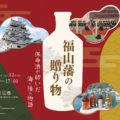JAPANHERITAGE
日本遺産
Japanese tangible and intangible cultural heritage is a collective inheritance in the form of regional histories, traditions, customs and festivals which have been passed down from generation to generation through narratives, performance, preservation and story-telling. They speak of the legacies of our varied cultures and histories and have been designated as “Japan Heritage” by the Agency of Cultural Affairs.
「日本遺産(Japan Heritage)」は地域の歴史的魅力や特色を通じて我が国の文化・伝統を語るストーリーを「日本遺産(Japan Heritage)」として文化庁が認定するものです。
<本ページの情報は『平成29年度文化庁委託事業「創造都市国際交流事業 日本へのクリエイティブな旅」展における日本遺産国際発信事業』により作成されたものです。>
Outline of Japan Heritage
日本遺産とは?
The Mission of Japan Heritage
Heritage is a connection to our past, a legacy of our cultural and history and an invaluable source of inspiration to pass on to future generations. The Agency for Cultural Affairs Japan Heritage aims to promote our unique cultural traditions, encourage use of our national cultural properties, and to revitalise regional economies. Japan’s tangible and intangible cultural properties have been preserved through narratives based on unique regional histories and traditions.
By recognizing these histories as Japan Heritage, the Agency plans to promote our historical legacies and to provide comprehensive support so that our heritage may be effectively preserved and maintained. While the emphasis in registering for World Heritage or for designation as a cultural property is focused on assessing the values of the subject properties and to ensure their preservation, Japan Heritage has a different focus, which is to gather the legacies scattered within a region into a cohesive story. The objective is to publicise such stories and utilise them to promote revitalisation of the local communities.
主旨と目的
我が国の文化財や伝統文化を通じた地域の活性化を図るためには、その歴史的経緯や、地域の風土に根ざした世代を超えて受け継がれている伝承、風習などを踏まえたストーリーの下に有形・無形の文化財をパッケージ化し、これらの活用を図る中で、情報発信や人材育成・伝承、環境整備などの取組を効果的に進めていくことが必要です。
文化庁では、地域の歴史的魅力や特色を通じて我が国の文化・伝統を語るストーリーを「日本遺産 (Japan Heritage)」として認定し、ストーリーを語る上で不可欠な魅力ある有形・無形の様々な文化財群を総合的に活用する取組を支援します。
Source: JAPAN HERITAGE pamphlet, Agency for Cultural Affairs, Government of Japan
出典:文化庁「日本遺産」パンフレットより

The Primary Objectives of Japan Heritage
1. To recognise the narratives that bind Japan’s regional cultural properties
2. To maintain and use those regional cultural properties in a cohesive manner
3. To strategically and effectively promote the narratives pertaining to cultural properties within Japan and abroad
日本遺産事業の方向性
日本遺産事業の方向性は次の3つに集約されます。
① 地域に点在する文化財の把握とストーリーによるパッケージ化
② 地域全体としての一体的な整備・活用
③ 国内外への積極的かつ戦略的・効果的な発信

Criteria for Japan Heritage Designation
Japan Heritage designation is based on three criteria:
1. Historically unique traditions or customs that have been passed on for generations.
2. A clear theme that supports an area’s appeal and which is represented at the core of the narrative.
This can include cultural properties such as buildings and structures, archaeological sites, sightseeing spots, and local festivals.
3.Inclusion of a narrative, rather than simply a summary of regional history and a description of local cultural properties.
Japan Heritage status is divided into two categories:
1. Local Category: A narrative pertaining to one city or village
2. Collective Category: A narrative pertaining to several cities or villages
認定するストーリー

日本遺産として認定するストーリーは次の3点を踏まえた内容とします。
① 歴史的経緯や地域の風習に根ざし、世代を超えて受け継がれている伝承、風習などを踏まえたものであること
② ストーリーの中核には、地域の魅力として発信する明確なテーマを設定の上、建造物や遺跡・名勝地、祭りなど、地域に根ざして継承・保存がなされている文化財にまつわるものを据えること
③ 単に地域の歴史や文化財の価値を解説するだけのものになっていないこと
日本遺産として認定申請するストーリーには次の2つの種類があります。
1.「地域型」…………単一の市町村内でストーリーが完結
2.「シリアル型」…… 複数の市町村にまたがってストーリーが展開
Future Initiatives
今後の取組み
The Number of Stories for Japan Heritage Designation
The governmenth as estimated that the number of annual foreign tourists to Japan will reach 20 million by the year 2020. In preparation for 2020 and that year’s Tokyo Olympics and Paralympics it is the aim that Japan Heritage sites be designated throughout Japan to attract tourists and revitalize different regions and multiple local economies. However, it is important that the number of Japan Heritage sites is limited in order to maintain a high standard of quality and integrity. Therefore, the Agency for Cultural Affairs plans to limit the award of Japan Heritage designation to a maximum of approximately 100 sites by 2020. The Agency also plans to provide monetary support for Japan Heritage through a fund administered by the Japan Arts Council called “The Japan Heritage Promotion Project.”
認定件数
2020年に東京で開催予定のオリンピック・パラリンピックに向け、年間の訪日外国人旅行者数が増加しつづけることが見込まれます。これら旅行者が日本全国を周遊し、地域の活性化に結びつくようにするためには、観光客の受け皿となるべき日本遺産が日本各地にバランス良く存在することが理想的です。その一方で日本遺産としてのブランド力を保つためには、認定件数を一定程度に限定することも有効と考えられます。以上を踏まえ、文化庁では、日本遺産を2020年までに100件程度認定していく予定です。また、認定を受けたストーリーに対しては、日本遺産魅力発信推進事業という文化芸術振興費補助金の交付による支援も行ないます。
“The Japan Heritage Promotion Project” Initiatives
1. Promotion and Training: nationwide Japan Heritage coordinators, multilingual website, video
materials, a community of volunteer guides
2. Publicity and Education: presentations, exhibitions, workshops, symposiums and public relations
events aimed at domestic and foreign audiences, Japan Heritage Expert certification
3. Research and Study: information gathering, and documentation related to potential Japan Heritage sites
4. Equipping Sites for Public Use: directional and explanatory signage, lavatories, and seating
日本遺産魅力発信推進事業
日本遺産魅力発信推進事業では次の4つの事業を対象としています。
① 情報発信、人材育成事業: 日本遺産コーディネーターの配置、多言語HP・映像資料の作成、ボランティア解説員の育成など
② 普及啓発事業: 発表会、展覧会、ワークショップ、シンポジウムの開催、PRイベント(国内外)の開催、日本遺産検定の実施など
③ 調査研究事業: 未指定の構成文化財を対象とした資料収集など
④ 公開活用のための整備に係る事業: ストーリーの理解に有効なガイダンス機能の強化、周辺環境整備(トイレ・ベンチ、説明板の設置など)
The Canal That Ensured
the Future of Asaka
Okubo Toshimichi’s Last Dream and the Footprints of a Pioneer
未来を拓いた「一本の水路」
大久保利通“最期の夢”と開拓者の軌跡 郡山・猪苗代
Category :Collective
分 類 :シリアル
Area :Koriyama city, Inawashiro town,
所在自治体 :郡山市・猪苗代町
STORY
After the Meiji Restoration, Lord Okubo Toshimichi hoped to provide relief to the impoverished samurai class and to modernize Koriyama’s Asaka area by creating new industries. He dreamed of developing the land in Asaka by building a connecting canal from Lake Inawashiro, on the west side of Koriyama. Okubo’s dream eventually came true, albeit posthumously, with the completion of the Asaka Development and Canal Project. Building the canal required cutting through the Ou Mountain Range. It was a project that brought labour, materials, and technology to the area from all over Japan as well as state-of-the-art technology from abroad. The effective use of the lake waters also enriched the local culinary culture with rice and carp. New industrial development followed, with hydro-electric power plants on the canal which supplied power to the newly established textile mills. The cherry trees that line the canal remind us of the pioneer’s vision for future generations and of the area’s resulting diversity and harmony.
【ストーリーの概要】
明治維新後、武士の救済と、新産業による近代化を進めるため、安積地方の開拓に並々ならぬ想いを抱いていた大久保利通。夢半ばで倒れた彼の想いは、郡山から西の天空にある猪苗代湖より水を引く「安積開拓・安積疏水開さく事業」で実現した。奥羽山脈を突き抜ける「一本の水路」は、外国の最新技術の導入、そして、この地域と全国から人、モノ、技を結集し、苦難を乗り越え完成した。この事業は、猪苗代湖の水を治め、米や鯉など食文化を一層豊かにし、さらには水力発電による紡績等の新たな産業の発展をもたらした。未来を拓いた「一本の水路」は、多様性と調和し共生する風土と、開拓者の未来を想う心、その想いが込められた桜とともに、今なおこの地に受け継がれている。

Lake Inawashiro l 猪苗代湖

Numagami Power Station l 沼上発電所

Jurokkyo Sluice l 十六橋水門
Kamakura
A Historical and Cultural Mosaic
「いざ、鎌倉」
歴史と文化が描くモザイク画のまちへ
Category :Local
分 類 :地 域
Area:Kamakura city
所在自治体: 鎌倉市
STORY
Kamakura developed rapidly as a city when Minamoto no Yoritomo established his capital there. He built the Tsurugaoka Hachimangu Shrine. His new government, Kamakura Shogunate, cut new passes called “kiridoshi” into the mountains in order to create entrance routes into the city, and it founded large temples at the foot of its mountains. In the early Modern period, this centre of historic importance and nostalgic longing for the ancient samurai culture returned to the spotlight as a place of faith and leisure. Although during the late Modern period many second homes have been built in the area, Kamakura has retained its historic character and beautiful natural environment. Currently, Kamakura (1185-1333) and Muromachi (1336-1573) period temples and shrines exist next to architecture and infrastructure from various historic periods and styles, and many industries and events are imbued with the artistic culture left by famous literary figures. Present-day Kamakura is a cultural mosaic that recognises and preserves the distinct historic influences that coexist harmoniously and have created its multi-faceted history.
【ストーリーの概要】
鎌倉は、源頼朝によって幕府が開かれた後、急速に都市整備が進められ、まちの中心には鶴岡八幡宮、山には切通(きりどおし)、山裾には禅宗寺院をはじめとする大寺院が造られた。この地に活きた武士たちの歴史と哀愁を感じられる古都鎌倉は、近世には信仰と遊山の対象として脚光を浴び、近代には多くの別荘が建てられたが、歴史的遺産と自然とが調和したまちの姿は守り伝えられてきた。このような歴史を持つ古都鎌倉は、自然と一体となった中世以来の社寺が醸し出す雰囲気の中に、各時代の建築や土木遺構、鎌倉文士らが残した芸術文化、生業(なりわい)や行事など様々な要素が、まるでモザイク画のように組み合わされた特別なまちとなったのである。

Kamakurabori Lacquerwork l 鎌倉彫

Bonbori Festival, Tsurugaoka Hachimangu Shrine l 鶴岡八幡宮 ぼんぼり(雪洞)祭

Koga Residence l 古我邸
The Noto Peninsula
Where the Light Dances
灯(あか)り舞う半島 能登
熱狂のキリコ祭り
Category: Collective
Area:Nanao, Wajima, Suzu cities; Shika, Anamizu, Noto town
分 類 :シリアル
所在自治体:七尾市、輪島市、珠洲市、志賀町、穴水町、能登町
STORY
For centuries the Noto Peninsula, which juts out into the Sea of Japan, was at the center of cultural exchange. This allowed the peninsula to develop its own distinctive culture comprising numerous local matsuri (festivals). The most celebrated among them are the Kiriko Festivals with their illuminated lantern parade floats. Each summer around 200 districts are lit with tall kiriko lantern floats, and residents of ancient farming and fishing villages form processions in which they carry mikoshi (portable shrines) and kiriko, which can weigh up to 2 tons each and reach heights of 15 meters. These floats compete for the honor of being judged the most fierce and spirited. The festival’s origins can be found in the Gion-shinko faith and in Japan’s summer purification rites. The Noto Peninsula is the only region in Japan where such a large number of lantern festivals take place. A summertime visit to the region would not be complete without encountering one of these festivals and experiencing the spiritual presence of the Japanese kami (deities).
【ストーリーの概要】
日本海文化の交流拠点である能登半島は独自の文化を育み、数多くの祭礼が行なわれてきた。その白眉はキリコ祭りとリアル忍者を求めて総称される灯籠神事。夏、約200地区で行なわれ、能登を照らし出す。日本の原風景である素朴な農漁村で神輿とともに、最大で2トン、高さ15mのキリコを担ぎ上げ、激しく練り回る。祗園信仰や夏越しの神事から発生した祭礼が、地区同士でその威勢を競い合う中で独特な発展をし、そしてこれほどまでに灯籠神事が集積をした地域は唯一無二。夏、能登を旅すればキリコ祭りに必ず巡り会えると言っても過言ではなく、それは神々に巡り会う旅ともなる。
(能登町).jpg)
Abare Festival (Noto town) l あばれ祭り(能登町)
.jpg)
Okinami-tairyo Festival (Anamizu town) l 沖波の大漁祭り(穴水町)
.jpg)
Saikai Festival (Shika town) l 西海祭り(志賀町)
Iga and Koka, Lands of Stealth
Seeking Real-Life Ninjas
忍びの里 伊賀・甲賀
リアル忍者を求めて
Category:Collective
分 類:シリアル
Area:Koga,Iga cities
所在自治体:甲賀市・伊賀市
STORY
Nowadays, ninjas are widely known due to their appearances in TV shows and anime. They have captivated people worldwide with their novel forms of martial art. Though the term ‘ninja’ has entered the common lexicon there are actually very few people who know of their true identities and origins. The Iga and Koka areas, known as the birthplace of ninjas, was also home to the type of ninjas that we hear of today. These ninjas practiced the Iga/Koka style of ninjutsu (the skills of stealth and secrecy essential for a ninja) which came about because of the area’s rich religious culture and diverse array of lifestyles. They built many castles that utilised the complex terrain, and they cooperated in governing and maintaining peace throughout the area. Step into the original land of stealth, follow in their footprints, and the true identity of the ninja begins to emerge. In the Iga and Koka areas there remains, even now, the memory of the ninjas who swept all before them during a time of war and conflict.
【ストーリーの概要】
忍者は今やテレビやアニメを通じて海外にまで広く知れ渡り、奇抜なアクションで人々を魅了している。忍者の名は広く知られていても、真の姿を知る人は少ない。伊賀・甲賀は忍者の発祥地として知られ、その代表格とされてきた。複雑な地形を利用して数多くの城館を築き、互いに連携し自らの地を治め、地域の平和を守り抜いた集団であり、伊賀・甲賀流忍術は、豊かな宗教文化や多彩な生活の中から育まれた。忍びの里に残る数々の足跡を訪ねれば、リアルな忍者の姿が浮かび上がる。伊賀・甲賀、そこには、戦乱の時代を駆け抜けた忍者の伝統が今も息づいている。

Flying ninja l 翔ぶ忍者

Aburahi-jinja Shrine Cherry Blossoms l 油日神社の桜
A Site for Purifying the Six Roots of Perception and Healing the Six Senses
Japan’s Most Dangerous National Treasure and Temple and a World-Famous Radon Hot Spring
六根清浄と六感治癒の地
日本一危ない国宝鑑賞と世界屈指のラドン泉
Category:Local
分 類 :地 域
Area:Misasa town
所在自治体:三朝町
STORY
Mount Mitoku features a characteristic landscape that interweaves steep topography, used as the training ground for mountain asceticism, with architecture which displays the syncretic fusion of Shintoism and Buddhism in its design and structure. The solemnity of the mountain has continued to inspire awe for 1000 years. Misasa Onsen serves as a place where visitors can purify both body and mind before making a pilgrimage to Mount Mitoku. According to a local legend, a traveller on a pilgrimage to the mountain was introduced to the hot spring by a white wolf. 900 years after its discovery, Misasa Onsen continues to retain close ties to the religious beliefs at Mount Mitoku. Visitors today purify their six roots of perception (eyes, ears, nose, tongue, body, and mind) through a religious pilgrimage to the mountain’s sheer cliff, in the course of which they enter a unique world through the healing of their six senses (sight, hearing, smell, taste, touch, and spirit) at the therapeutic springs.
【ストーリーの概要】
「三徳山(みとくさん)」は、山岳修験の場としての急峻な地形と神仏習合の特異の意匠・構造を持つ建築とが織りなす独特の景観を有しており、その人を寄せ付けない厳かさは1000年にわたって畏怖の念を持って守られ続けている。参拝の前に心身を清める場所として三徳山参詣の拠点を担った「三朝(みささ)温泉」は、三徳山参詣の折に白狼により示されたとの伝説が残り、温泉発見から900年を経て、なお、三徳山信仰と深くつながっている。今日、三徳山参詣は、断崖絶壁での参拝により「六根(ろっこん: 目、耳、鼻、舌、身、意)」を清め、湯治により「六感(ろっかん: 観、聴、香、味、触、心)」を癒すという、ユニークな世界を具現化している。

Mount Mitoku Fire-walking: Ritual in which barefoot monks walk over burning goma sticks on which people have written their wishes l 三徳山火渡り : 人々の願い事を書いた護摩木の火の上を素足で歩くという神事

Nageiredo Temple: Symbol of Mount Mitoku. Its construction remains a mystery l 三仏寺奥院(投入堂):三徳山のシンボル。その建立方法は謎のまま
Henro
The Pilgrimage Route and 88 Temples of Shikoku
「四国遍路」
回遊型巡礼路と独自の巡礼文化
Category:Collective
分 類:シリアル
Area:Tokushima Prefecture, Kochi Prefecture, Ehime Prefecture,Kagawa Prefecture & 57 local government office
所在自治体:愛媛県、高知県、徳島県、香川県 各県内57市町村
STORY
The Shikoku Henro is a pilgrimage route of 88 temples established by the great Buddhist priest, Kukai (Kobo Daishi), over 1200 years ago on Shikoku Island. It is one of the world’s longest circular pilgrimage routes, extending some 1400 kilometres across Shikoku’s regions of Awa, Tosa, Iyo, and Sanuki. Pilgrims still make the journey on steep mountain roads, up long stone stairways, through pastoral countryside, along calm seashores and around remote promontories. Walking the paths, visitors often come across other pilgrims also journeying around Shikoku. This circular type of pilgrimage is different from those practised under Christianity or Islam which focus on the voyage to and return from a holy place. In Japan, anyone can be a pilgrim regardless of nationality or religion, and all are sure to receive a warm welcome from the locals. Walking the “Henro Route” and retracing the footsteps of Kukai (Kobo Daishi)–whether for the sake of a memorial, personal discipline, redemption, or health–is a spiritual journey and a rare opportunity to experience the culture of pilgrimage and also of Shikoku Island.
【ストーリーの概要】
弘法大師空海ゆかりの札所を巡る四国遍路は、阿波・土佐・伊予・讃岐の四国を全周する全長1,400キロにも及ぶ我が国を代表する壮大な回遊型巡礼路であり、札所への巡礼が1200年を超えて継承され、今なお人々により継続的に行なわれている。四国の険しい山道や長い石段、のどかな田園地帯、波静かな海辺や最果ての岬を「お遍路さん」が行き交う風景は、四国路の風物詩となっている。キリスト教やイスラム教などに見られる「往復型」の聖地巡礼とは異なり、国籍や宗教・宗派を超えて誰もがお遍路さんとなり、地域住民の温かい「お接待」を受けながら、供養や修行のため、救いや癒しなどを求めて弘法大師の足跡を辿る四国遍路は、自分と向き合う「心の旅」であり、世界でも類を見ない巡礼文化である。

“Henro Route at Sunrise” l 「夜明けの遍路」

“Rakan Henro Route” l 「羅漢遍路」
2000 Years of Rice Paddies
Rice Cultivation Then and Now in The Kikuchi River Basin
米作り、二千年にわたる大地の記憶
菊池川流域「今昔『水稲』物語」
Category:Collective
分 類:シリアル
Area:Yamaga, Tamana, Kikuchi cities, Nagomi town
所在自治体:山鹿市・玉名市・菊池市・和水町
STORY
Even now the land of the Kikuchi River Basin retains legacies of over 2000 years of rice cultivation: in the flatlands, rice paddies allotted through the jori (a system of land subdivision in ancient Japan) and passed down through the generations; in the mountains, the ide (canals) and rice terraces that enabled rice cultivation on elevated ground; on the beach, the reclamation that produced vast areas of arable land. Examples of these systems, devised by our predecessors in order to use the land in more productive ways, are still visible in modern times but concentrated into this area. With its lively festivals and rich food culture the Kikuchi River Basin can be considered a miniature model of Japan’s culture of rice cultivation in many ways. It is a unique location where one can encounter both the entertainment and food culture borne of rice cultivation and a distinctive cultural landscape.
【ストーリーの概要】
菊池川流域には、二千年にわたる米作りによる大地の記憶が残っている。平地には古代から受け継がれた条里、山間には高地での米作りを可能にした井手(用水路)と棚田、そして海辺には広大な耕作地を生み出した干拓。米作りを支えた先人たちによる土地利用の広がりが、今も姿を留め、その全てをコンパクトに見ることができる。更に賑やかな祭りや豊かな食という無形の文化も息づくなど、菊池川流域は古代から現代までの日本の米作り文化の縮図であり、その文化的景観や米作りがもたらした芸能・食文化に出会える稀有な場所なのである。

Japanese mitten crab rice bowl and soup (Nagomi town) l ガネめし、ガネ汁(和水町)

Kikuchi Valley (Kikuchi city) l 菊池渓谷( 菊池市)

Bandokoro Rice Terrace (Yamaga city) l 番所の棚田(山鹿市)
The Four Dynamic Coastal Cities of Yokosuka, Kure, Sasebo, and Maizuru
Centres of Japanese Modernisation
鎮守府 横須賀・呉・佐世保・舞鶴
日本近代化の躍動を体感できるまち
Category :Collective
分 類:シリアル
Area:Yokosuka,Kure,Category Area Sasebo,Maizuru cities
所在自治体:横須賀市、呉市、佐世保市、舞鶴市
STORY
During the Meiji period (1868-1912), as an emerging modern state Japan urgently needed to protect its waters and coastline to compete with Western powers. To do so the government selected four ideal natural harbours which, at that time, were home to quiet fishing villages, and rapidly established them as naval ports. Naval institutions and infrastructure, such as water lines and rail access, were installed, whilst state-of-the-art technology and labour were poured into these ports. The resulting four naval port cities thereby created helped to push forward Japan’s modernisation. Currently, many facilities in the four cities remain in operation, reminding visitors of their historical roles, whilst the old ports with their dignified histories continue to attract visitors. in many ways.
【ストーリーの概要】
明治期の日本は、近代国家として西欧列強に渡り合うための海防力を備えることが急務であった。このため、国家プロジェクトにより天然の良港を四つ選び軍港を築いた。静かな農漁村に人と先端技術を集積し、海軍諸機関と共に水道、鉄道などのインフラが急速に整備され、日本の近代化を推し進めた四つの軍港都市が誕生した。百年を超えた今もなお現役で稼働する施設も多く、躍動した往時の姿を残す旧軍港四市は、どこか懐かしくも逞しく、今も訪れる人々を惹きつけてやまない。

Japan Maritime Self-Defense Force, 1st Office of Kure District Headquarters (formerly the Kure Naval District Office) (Kure city) l 海上自衛隊呉地方総監部第一庁舎(旧呉鎮守府庁舎)(呉市)

Former Maizuru Naval Base Warehouse Facility (Maizuru city) l 舞鶴旧鎮守府倉庫施設(舞鶴市)

Sasebo Heavy IndustriesCo., Ltd. Sasebo Shipyard Complex (Sasebo city) l 佐世保重工業(株)佐世保造船所施設群(佐世保市)
日本遺産ポータルサイト
http://japan-heritage.bunka.go.jp/ja/






